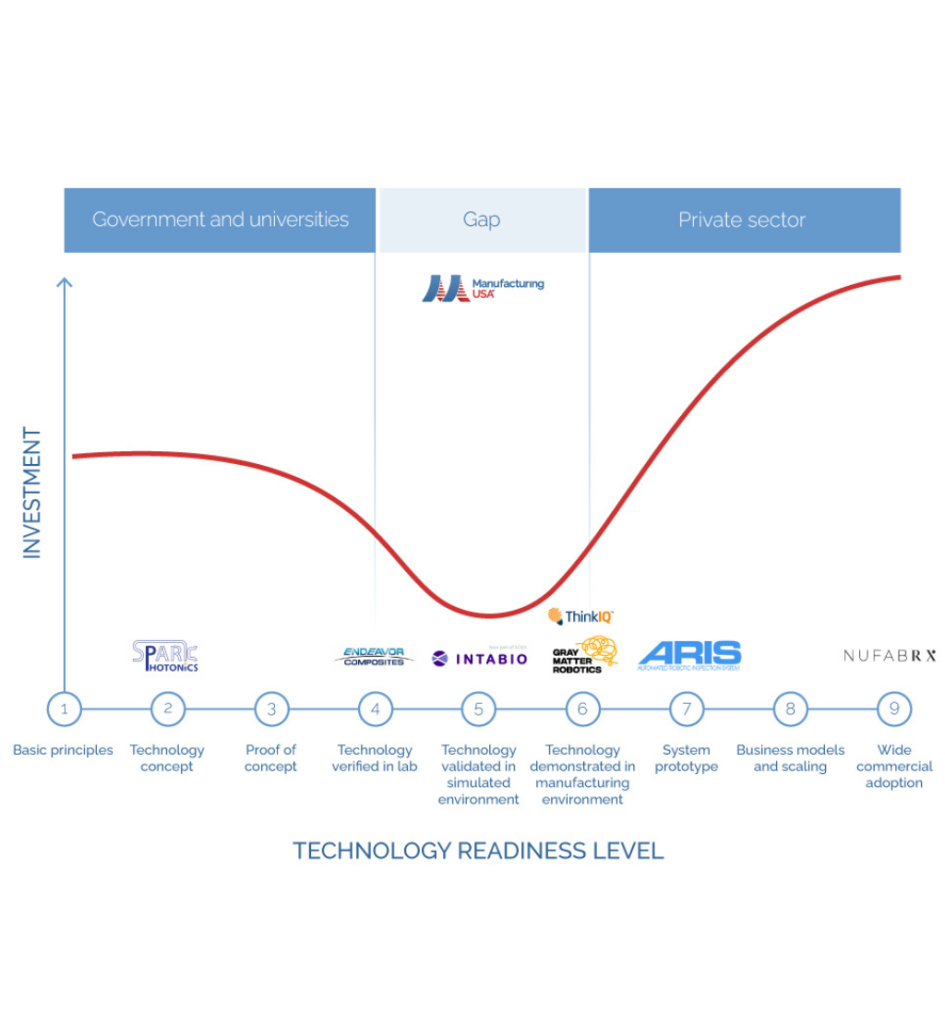
Spark Photonics
TRL: 2-4
Innovation: Designing integrated photonics semiconductor circuits to be built in chip foundries. Will soon begin sale of process design kits (PDK) for testing environments.
Institute of origin: AIM Photonics
Pathway into AIM: Co-founder Kevin McComber was working at MIT, an AIM partner, and saw the need to build the educational ecosystem for integrated photonics and provide design services. The company was the first to launch with AIM intellectual property.
Endeavor Composites
TRL: 3.5-6
Innovation: Developing ways to repurpose excess carbon fiber from other applications to drastically reduce costs while improving performance for non-woven composites. Will soon test a new process to reach TRL 6.
Institute of origin: IACMI
Pathway into IACMI: Founder Hicham Ghossein was a PhD student at the University of Tennessee and doing research at an IACMI facility. He started the company through the Innovations Crossroads program, which provided matching funds from the Department of Energy’s Advanced Manufacturing Office and the Oak Ridge National Laboratory.
Intabio/SCIEX
TRL: 5
Innovation: Developed testing for biotherapeutic analysis and quality assessment that reduced testing time by 30x, which increased testing capacity from 3-5 samples per month to 100 overnight. This reduced costs of a sample from as high as $23,000 to as little as $65.
Institute of origin: NIIMBL
Pathway into NIIMBL: Project call with industry giants Merck & Co., Genentech, Bristol-Myers Squibb and MillporeSigma. Lena Wu, co-founder of Intabio, said the institute network was able to validate the need in the market and provide feedback much faster and efficiently than they imagined. SCIEX acquired Intabio in 2021.
ThinkIQ/Atollogy
TRL: 6-7
Innovation: Developed an industry-leading information modeling platform that enables manufacturers to easily capture, structure and visualize data from machines and humans on the shop floor. The platform generates dashboards as well as predictive insights that guide smart, data-driven business decisions.
Institute of origin: CESMII
Pathway into CESMII: ThinkIQ recently acquired Atollogy. Both startups have been members since the inception of the institute and have participated in project calls and received funding. The institute helped highlight the synergy between the companies, and adding niche technology to a platform has helped accelerate the adoption of smart manufacturing applications.
GrayMatter Robotics
TRL: 6-9
Innovation: Developing smart robotic cells for surface finishing and treatment applications such as sanding, polishing, and spraying. Also developing proprietary AI algorithms that enable industrial robots to program themselves, which will greatly improve adoption.
Institute of origin: ARM Institute
Pathway into ARM: Co-founders were in graduate school at the University of Southern California working on a robotic sanding project funded by the ARM Institute and saw the opportunity to find companies with solutions to replace dangerous manual labor no one wants to perform.
ARIS Technologies
TRL: 7-9
Innovation: Developed an easy-to-train robotic process for 3D inspection, which has been labor intensive, to provide savings and autonomy. The interface will increase robotic adoption, and the Artificial Intelligence (AI) learns from the robot’s 3D perception data, improving the productivity of the robotic process.
Institute of origin: ARM Institute
Pathway into ARM: ARIS was founded by Mingu Kang in 2013 and was a member of MxD, a Manufacturing USA institute in his area. Kang was introduced to the ARM Institute from his DOD contacts at MxD, and the company used a project call to access funding and resources to pursue R&D collaboration.
Nufabrx
TRL: 7-9
Innovation: Helped create the Healthwear category by putting active ingredients into textile fabrics, such as an arm sleeve, which can be programmed for controlled release to the skin. Now available nationwide in prominent retailers.
Institute of origin: AFFOA
Pathway into AFFOA: Jordan Schindler had already founded the company and supported the proposal submission to stand up AFFOA. The company advanced its primary technology in AFFOA’s first project call and has continued development through an additional grant.

